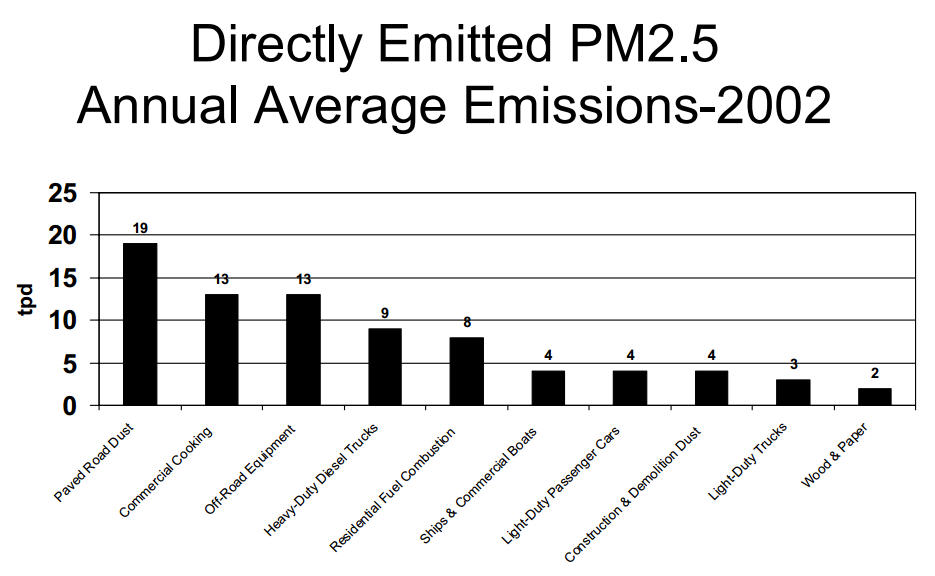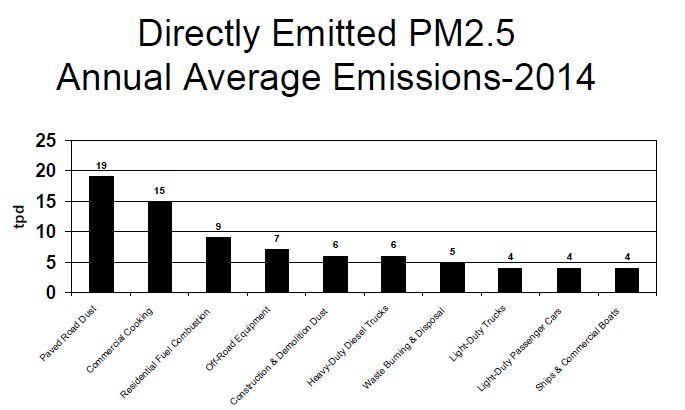So you can imagine my surprise when I got a U.C. Riverside press release this week saying that char-broiling a hamburger in a restaurant is worse for the environment than driving an entire 18-wheeler truck. That's all you need to get coverage on CBS or into Huffington Post, especially if it is a slow news day for scare journalism or Miracle Vegetable of the Week stories, but we have a higher standard here so I thought about it. Bill Welch, principle engineer in the CE-CRT group at UC Riverside, was quoted as saying, “For comparison, an 18-wheeler diesel-engine truck would have to drive 143 miles on the freeway to put out the same mass of particles as a single charbroiled hamburger patty.”
Stop and think about that for a second. A restaurant cooked a hamburger and it did more to cause pollution than driving a giant, emissions-belching diesel truck 143 miles?
It's catchy, it's counter-intuitive, but is it true?
I wrote Welch because the first thing I tried to do was reverse engineer the method and couldn't figure out where he got his numbers. I had the South Coast Air Quality Management District (SCAQMD) analysis. It is a document with 7 pages of WHEREAS statements showing all of the reasons, both federal and state, you will need to pay more taxes and more for hamburgers, and it shows emissions both measured and projected, but it doesn't show any way that trucks are really worse than hamburgers for pollution.
There had to be a secret sauce in his hamburger recipe.
He wrote back that he used the same document I did but said that it read "PM inventory from commercial cooking more than double the inventory from heavy-duty diesel trucks" so I looked just at those sections again.
In 2007 they had actual results from 2002 and projections of 2014. I am fine with projections and these were not outrageous.
Here are the two charts.

Projected results of 2014 made in 2007:

You probably chuckled that the number one is dust and that remains flat but they have diesel truck particulate matter dropping from 9 tons per day (TPD) to 6 in 12 years, which is .25 TPD per year. Obviously we can just take 2.5 from 9 and assume they had a reasonable idea their mandates would drop diesel truck particulate matter to 6.5. Commercial cooking was projected to go from 13 to 15 over 12 years, so we should be at about 14.67 now if restaurants continued to open and cook hamburgers as projected in 2007. So his statement about 'more than double' holds up. He's even a little conservative.
His other steps are pretty intuitive:
Emissions from model years 2007-2010 Class 8 heavy-duty diesel trucks = 35 mg/mile
Emissions from charbroiled hamburgers = 33 lbs. PM/1000 lbs.meat cooked
Calculations:
(33 lbs. PM/1000 lbs meat) x (1/3 lb./patty) x (454 g/lb) = 4.994 g PM/patty
(4.994 g PM/patty) x (1000 mg/g)/(35 mg/mile) =142.7 milesNothing to argue there, 143 miles to match a hamburger particulate matter it is. A head scratcher, but reasonable.
Yet you can see in the charts above diesels are just part of even the true particulate matter story and emitted particulate matter is a small part of air pollution. When placed together, dust is no longer number one in directly emitted particulate matter, transportation is far and away the leader, more than dust and Burger King and those others combined. If these things were truly the simple way Huffington Post writes about them, we could just tell restaurants to cook 10 fewer hamburgers per day - that is 1,430 miles per day of diesel particulate matter per fast-food joint, which would wipe out the impact of diesel trucks and cargo ships and cars.
In the real world of emissions and pollution, it is a lot more complicated. Of the 99 tons per day of particulate matter emissions, charbroilers and stoves are really only 1.4 tons . And that emitted particulate matter in those charts is only 25% of all ambient particulate matter. 5.5 tons are coming from green waste composting and even more from livestock.
Welch is working on a solution to reduce particulate matter from under-fired charbroilers - those industrial units in restaurants that act like your outdoor grill. Their CE-CERT test laboratory created a device that removes grease from the exhaust and traps it in water. It sounds like cool technology but taxpayers want to know how effective it will be. While hamburgers do have twice the particulate matter of diesel trucks, that is one small part of why driving diesel engines is still worse for the air than Wendy's. How effective will this be in really reducing emissions versus cost? Of the 12 solutions in that 2007 proposal, this was dead last in efficiency, a cost of a whopping $13-15,000/ton.
Taken on a true cost versus benefit basis, we would help Californians more by outlawing composting than by forcing restaurants to retrofit so that they 'do their part' in reducing emissions.
Verdict: It sure does release more particulate matter to cook that hamburger than drive a diesel truck, but simply buying fewer hamburgers won't solve our pollution problems.





Comments